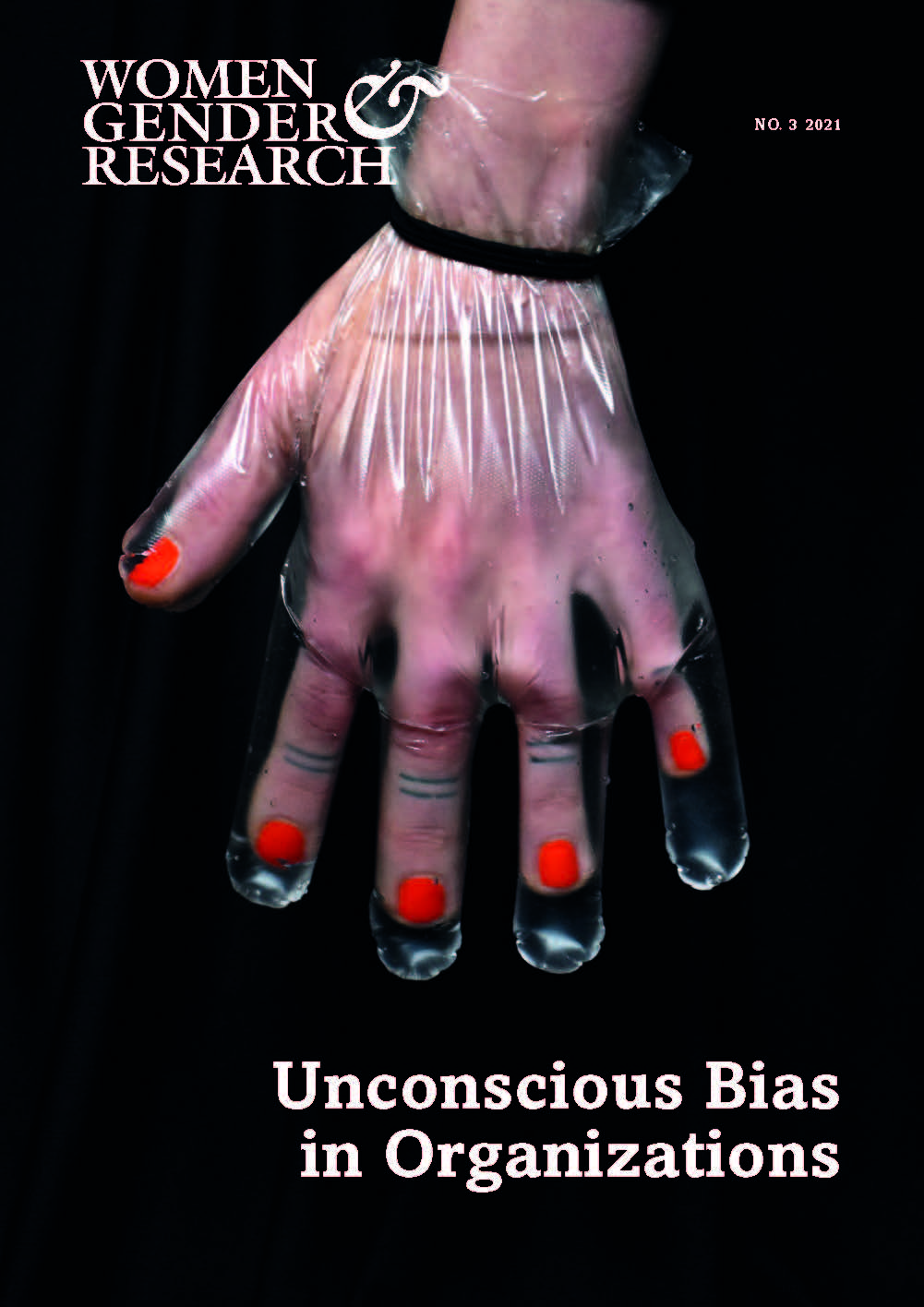Doing Un/Troubled Subject Positions as a Transgender Woman with Autism
The Case of Vera
DOI:
https://doi.org/10.7146/kkf.v31i3.128180Nøgleord:
Transgender, Autism, Troubled Subject Positions, Identity, Intelligibility, IntersectionalityResumé
This paper aims to capture in/exclusion processes in the life of a transgender person who is also diagnosed with autism. We use Staunæs’ (2005) concept of troubling subjectivities to explore how Vera negotiates her identities as a neurodiverse transgender woman. We pay particular attention to how the categories of transgender and autism intersect and which in/exclusion processes they set in motion. We unfold how identifying as transgender and being diagnosed with autism spectrum disorder shape Vera’s life. Specifi cally, we aim to unveil how these social categories shape her degree of agency in her private social relations and in institutional settings of education and healthcare. This is important because: a) research shows that a signifi cant number of transgender people also inhabit the clinical category of autism; and b) the intersections of multiple social categories change the conditions under which someone is allowed to do their particular personhood in different social settings. We show that while Vera is able to perform identities related to the categories of transgender and autism in personally empowering ways, she is also obstructed by identity overwork. That is, others’ positioning of Vera as troubled repeatedly requires her response on multiple social levels and in various contexts.
Referencer
Ahmed, S. (2017). Living A Feminist Life. Durham & London: Duke University Press.
Amnesty International Report (2014). The State Decides Who I am: Lack of Legal Gender Recognition for Transgender People in Europe.
Butler, J. (2004a). Precarious Life - The power of mourning and violence. London: Verso
Butler, J. (2004b). Undoing Gender. London: Routledge
Coleman, E., Bockting, W., Botzer, M., Cohen-Kettenis, P., DeCuypere, G., Feldman , J. Fraser , L., Green, J., Knudson, G., Meyer, W. J., Monstrey, S., Adler, R. K., Brown, G. R., Devor, A. H., Ehrbar, R., Ettner, R., Eyler, E., Garofalo, R., Karasic, D. H., Lev, A. I., Mayer, G., Meyer-Bahlburg, H., Hall, B. P., Pfaefflin, F., Rachlin, K., Robinson, B., Schechter, L. S., Tangpricha, V., van Trotsenburg, M., Vitale, A., Winter, S., Whittle, S., Wylie, K. R., & Zucker, K. (2012). Standards of Care for the Health of Transsexual, Transgender, and Gender-Nonconforming People, Version 7. International Journal of Transgenderism 13, 165-232.
Clare, E. (2017). Brilliant Imperfection – grappling with cure. Durham & London: Duke University Press.
Davies, B. (2006). Subjectification: the relevance of Butler´s analysis for education. British Journal of Sociology of Education, 27 (4), 425-438.
De Vries, A. L. C., Noens, I. L. J., Cohen-Kettenis, P. T. et al. (2010). Autism spectrum disorder in gender dysphoric children and adolescnets. Journal of Autism Development Disorder 40, 930-936.
Dietz, C.P. (2016). Jurisdiction in Gender Recognition: Governing Legal Embodiment. The University of Leeds.
Enke, F. (2012). Introduction: Transfeminist perspectives. Transfeminist Perspectives in and
Beyond Transgender and Gender Studies, 1–15.
Foucault, M. (1980). Two lectures. In C. Gordon (Ed.) Michel Foucault power/knowledge: Selected interviews and other writings 1972-1977 by Michel Foucault. NY: Pantheon Books.
Glidden, D., Bouman, W. P., Jones, B. A., and Arcelus, J. (2016). Gender dysphoria and autism spectrum disorder: A systematic review of the literature. Sexual Medicine Reviews 4 (1), 3-14.
Herold, M. D. (2016). ‘Skæve' venskaber’: Et kønnet blik på stoferfarne unges venskabsfortællinger. I M. U. Pedersen, & S. R. (red.), Unge liv: Tilhør og udfordringer (s. 131-153). Aarhus Universitetsforlag. Samfund og Rusmidler 4.
Herold, M. D. (2015). Between decency, maturity and oppositional unity: Exploring young women's romantic identity work following extensive drug use. Drugs: Education, Prevention and Policy, 22(3), 193-200.
Holm, S. (2017). Fleshing out the self: Reimagining intersexed and trans embodied lives through (auto)biographical accounts of the past. Linköping: LiU Tryck.
Namaste, V. (2009). Undoing theory: The “transgender question” and the epistemic violence
of Anglo‐American feminist theory. Hypatia, 24(3), 11-32.
Occhino, M & Skewes, L. (2020). Gatekeepers for Gendersex Norms: Trans (Un)Intelligibility and (Il)Legitimacy Within the Danish Healthcare System, Nordic Journal of Feminist and Gender Research, 28 (4), 314-328.
Prosser, J. (1998). Second Skins: The Body Narratives of Transsexuality. Columbia University
Press.
Raun, T. (2014). Trans as Contested Intelligibility: Interrogating how Conduct Trans Analysis
with Respectful Curiosity. Lambadia Nordica, 1 13-37.
Raun, T. (2010). Skærmfødsler – en undersøgelse af det transformative potential i unge
transkønnedes videoblogs på YouTube. Akademisk kvater: tidsskrift for humanistisk
forskning 12 (9), 102-112.
Rudman, L. A. & Glick, P. (2010). The Social Psychology of Gender – How Power and Intimacy Shape Gender Relations. New York & London: The Guildford Press.
Shumer, D. E., Reisner, S. L., Edwards-Leeper, L. and Tishelman, A, (2016). Evaluation of Aspergers syndrome in youth presenting to a gender dysphoria clinic. LGBT Health 3 (5), 387-390.
Singh, A. A., Richomond, K., & Burnes, T. R. (2013). Feminist participatory action research with transgender communities: Fostering the practice of ethical and empowering research designs. International Journal of transgenderism, 14(3), 94-104.
Staunæs, D. (2003). Where Have All the Subjects Gone? Bringing together the concepts of intersectionality and subjectification. NORA: Nordic Journal of Women´s Studies, 11 (2), 101-110.
Staunæs, D. (2005). From culturally avant-garde to sexually promiscuous: Troubling subjectivities and intersections in the social transition from childhood to youth. Feminism and Psychology 15 (2), 149-167.
Stryker, S. (2017). Transgender History. The roots of today´s revolution (2nd. ed.). Berkeley, CA: Seal Press.
Turner, L. Whittle, S. and Combs, R (2009). Transphobic Hate Crime in the European Union. London: Press for Change.
Van Der Miesen, A. I. R., Hurley, H., and De Vries, A. L. C. (2016). Gender dysphoria and autism spectrum disorder: A narrative review. International Review of Psychiatry 28 (1).
Downloads
Publiceret
Citation/Eksport
Nummer
Sektion
Licens
Copyright (c) 2021 Lea Skewes, Molly Occhino, Maria Dich Herold

Dette værk er under følgende licens Creative Commons Navngivelse –Ikke-kommerciel (by-nc).
Udgivelser i Kvinder, Køn og Forskning er beskyttet under Creative Commons License: CC Attribution-NonCommercial 4.0

